Bijin-ga (美人画) literally means “picture of beautiful person”. They originate in the woodblock prints of the Edo era, and typically depicted beautiful women from various walks of life – from everyday women doing everyday things to famous courtesans reclining in luxurious surroundings. Many famous artists produced bijin-ga prints; some of the most well-known being Utagawa Kunisada, Kitagawa Utamaro, and Tsukioka Yoshitoshi.
Around the transitional period from late Meiji through Taisho into early Showa era, artists such as Jun’ichi Nakahara, Yumeji Takehisa, and Katsuji Matsumoto‘s modern styles made an enormous impact on traditional bijin-ga and produced works that helped form the flowery, large-eyed shoujo manga aesthetic as we know it.
With the advent of more modern printing technologies and digital painting, art has become more accessible than ever before. There are incredible modern artists out there today producing breathtaking works that continue to challenge the way we think of traditional Japanese art of gorgeous women. These are the sorts of artists I’m going to focus on. I urge you to check out their galleries, follow them on social media, and buy their prints to support them if you can.
While these featured artists are all incredibly versatile and do portraits of women in kimono and modern clothes as well as floral studies and still-lifes, I chose to focus on kimono-clad beauties to keep with the spirit of bijin-ga.
This entry will be long and image-heavy, so please click through to keep reading!
Ichiro Tsuruta
Ichiro Tsuruta Website | Facebook | Instagram
Ichiro Tsuruta is probably my favourite modern Japanese artist, and the one who inspired me to write this post. His work reminds me of Patrick Nagel’s iconic pop art; gorgeous stylised women evoking a very modern, almost art-deco feeling. Combine that with geisha and kimono, and you’ve got me hooked! There’s something so effortlessly elegant about the subjects of his work, something I admire and would love to be able to emulate.
Kisho Tsukuda
Kisho Tsukuda’s works most closely resemble traditional bijin-ga. There are no unconventional motifs, no pop-art influences, just beautiful, elegant women in gorgeous outfits. From schoolgirls to dancers, the subjects are always at the height of fashion and the epitome of “classic” Japan. Sadly, aside from a Japanese-language gallery Tsukuda does not have much in the way of an internet presence, but the works are so lovely I had to include them. Is that Taisho-feeling ro kimono in the second image not to die for?
Miki Katoh
Miki Katoh Website | Facebook | Instagram
Skilfully bridging the gap between traditional and modern, Miki Katoh paints beautiful and iconic women that feel timeless. She tends to stick to more classic looks and rich, warm colours, resulting in pieces that would look at home in any era.
Rieko Morita
Rieko Morita’s works feature gorgeous women in gorgeous kimono; mostly maiko, who are an art form in and of themselves. Her works lean very much towards the traditional, with emphasis on soft colours, ornate patterns, and warm tones. She also does some absolutely breathtaking flowers and botanicals. While it may not be entirely fitting the theme of this post, of course I had to include the yuugao (moonflower), how could I not?
Tamura Yoshiyasu
Tamura Yoshiyasu Website | Facebook | Instagram
Beautiful, surreal and slightly irreverent, Tamura Yoshiyasu’s artwork features quirky takes on traditional subject matter, rendered with lush colours and textures. Heavy use of materials like gold leafing and lots of bold red feel classic and vintage, but cyborg-like extensions and headpieces reminiscent of satellite dishes bring these pieces right into the 21st century.
Yoshimi Ohtani
Yoshimi Ohtani Website | Facebook | Instagram
By far the most “modern” feeling, Yoshimi Ohtani’s work has a definite manga influence to it. In some aspects, these works feel almost like the psychedelia of the 60s and 70s combined with modern trends and classic motifs. The women are of course as beautiful as ever, in a haunting and slightly detached way. To me, this style of art represents the best of many worlds all colliding.
Do you have any favourite modern Japanese artists that were not included? Please share them!


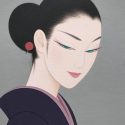
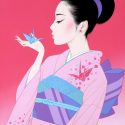
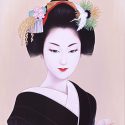
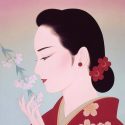
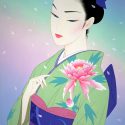
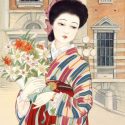
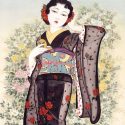
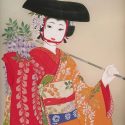
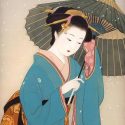
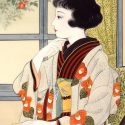
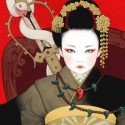
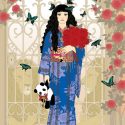
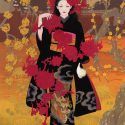
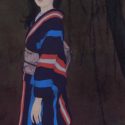
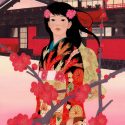
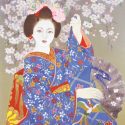

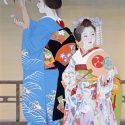

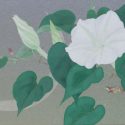
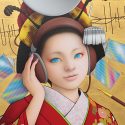
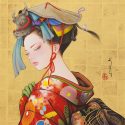
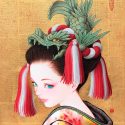
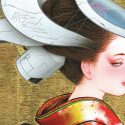
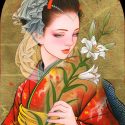
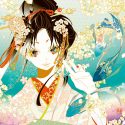
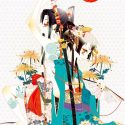
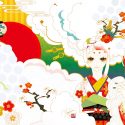
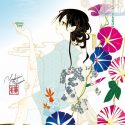
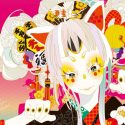
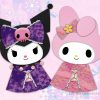













 Bebe Taian
Bebe Taian CHOKO Blog
CHOKO Blog Gion Kobu
Gion Kobu